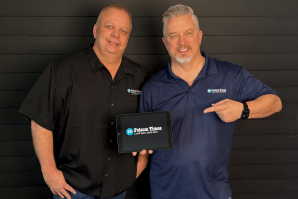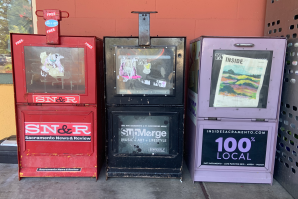Anastasia Murphy was looking for her second career. She spent two decades as a quality engineer at Intel and was ready to be her own boss. Opening a wine bar or a pottery studio came to mind, but an ad for the quarterly print magazine Edible Sacramento caught her eye. “I thought, well, food and wine, that’s right up my alley,” she says.
Murphy had the management skills needed but lacked an understanding of the ins and outs of the publishing world. That wouldn’t be an issue. It wasn’t a business for sale; it was a licensing agreement with Edible Communities.
The company has established more than 90 titles across the U.S. and Canada, each managed by local owners. Publishers buy the rights to run their own Edible magazine in a specific territory and operate it within certain parameters and standards. The publications feature stories on local restaurants and wineries, along with recipes.
Anastasia Murphy is the owner of Edible Sacramento. (Photo
courtesy of Anastasia Murphy)

From McDonald’s to Ace Hardware, franchises and licensing agreements permeate all sorts of industries, and media is no exception. Yes, you too can run your own Coastal Angler Magazine special-interest periodical, Bingo Bugle casino newsletter, Macaroni KID parenting blog or TAPinto local news site. The franchise model offers an onramp into the industry for entrepreneurs with the money but without the experience.
“Could I start something from scratch now? Possibly,” Murphy says. “Could I have then? No.” But legacy media is in decline, and these businesses aren’t any more successful than independently owned outlets in the Capital Region. Edible Sacramento for Murphy is a full-time job and a “passion project” supported by family members and freelancers who work more for the love of the craft than the money.
There are franchise publishers with higher budgets, like Katie MacDiarmid. A few years ago, she was also looking to start a business when she came across The N2 Company. The franchisor offers six magazine business models for franchisees to choose from. MacDiarmid was drawn to its publication for local real estate agents. “It was a lot of chance that I came across it, but then it picked a lot of things that I am just organically interested in,” MacDiarmid says.
Edible has established more than 90 titles across the U.S. and
Canada, each managed by local owners. (Photo courtesy of
Anastasia Murphy)

Since March 2020, MacDiarmid has sent free copies of Sacramento Real Producers to the top 500 performing real estate agents across Sacramento, Placer and El Dorado counties. The magazine is a cross between a yearbook and an award, as it primarily features profiles of its target audience.
“It’s a validation of an agent’s business,” MacDiarmid says. She earns enough revenue to afford freelance writers, photographers and a handful of full-time employees. She likes how N2 provides “the nuts and bolts to create the magazine” while she gets to interact and build relationships with readers.
That’s also what appealed to Carrie Sweet, who runs not one but two N2 franchises. She owns BeLocal Central Valley, a print welcome guide sent to new movers around Modesto, and Greet Ripon, a monthly magazine mailed to town residents. Sweet was looking to make some extra money and wanted to replace the town’s newspaper, the Ripon Record, which had closed a decade ago after 107 years of publication.
Sweet didn’t have a background in publishing, so she turned to N2 to handle the business side. Her main responsibility is selling ads and producing editorial content, which consists of articles on local events, charities, and businesses, written by herself and volunteers. “I just don’t think there’s any reason to reinvent the wheel when we have a really powerful national brand,” Sweet says.
Eric Inouye stands next to a sign featuring the Coffee News
mascot Little Bill while at his franchise organization in Bangor,
Maine. (Photo courtesy of Eric Inouye)

Unlike restaurants and retail stores, print publications have relatively low startup and overhead costs. There’s no equipment installation, no office space required and no inventory to manage. Most run the business out of their home. That’s what attracted Eric Inouye to Coffee News, a weekly print newsletter targeting patrons of restaurants and cafes across six countries.
Unlike other media franchisor, Inouye said corporate supplies all written content of “jokes, quotes, and horoscopes.” He just handles ad sales and local distribution. “The margins tend to be relatively high because your costs are relatively low,” Inouye says.
A few days onsite at the company’s office in Bangor, Maine and an initial investment of time, effort and capital was all it took for Inouye to get up and running last July in east Ventura County. However, his franchise is not his main source of income. “I happened to get going pretty quickly and brought on advertisers pretty quickly,” Inouye says. “That being said, you’re not going to get rich in this, right? It’s really a labor of love to a certain degree.”
That’s something that makes media businesses unique among franchises. Glenn Peterson, a franchise lawyer based in Roseville who has been in the industry for nearly four decades, has worked with few publishing franchises because they are simply less common. Probably the biggest reason is money.
Franchisors typically collect a percentage of gross revenue from franchisees, known as a franchise royalty fee. These typically range from 4 percent to 12 percent, according to the U.S. Small Business Administration. “That’s off the top line, so that is a rude awakening to a lot of operators,” Peterson says. A low-profit margin operation like a community newspaper, magazine or blog will struggle to pay those fees.
“Most people buy franchises to make money,” says Barry Kurtz, a franchise lawyer based in Encino with more than four decades of experience. Some families own multiple franchises, which serve as their main source of income.”There’s always a financial interest that they’re looking for. This is not something you do just for fun.” When it comes to the owners of franchised local media outlets, he said it appears “they do it for the journalism aspect of it, not necessarily only motivated by money.”
Media franchises from a legal standpoint are no different than other kinds of franchises and have the same government protections. “California has very robust franchise laws,” Peterson says. In 1970, the state enacted one of the first franchise disclosure laws in the nation.
According to the Department of Financial Protection’s website, the state’s Franchise Investment Law “generally requires franchisors to register with the department before offering and selling franchises in California.” The idea is to make them transparent about the business prospects with any potential franchisee.
If someone is going to buy any kind of franchise, Peterson and Kurtz advise them to do two things. First, have an attorney read over the franchise disclosure document. These outline what a person is signing up for. Franchise agreements are a legal commitment lasting years, often a decade or two.
“You’d be surprised how many people I’ve seen over the years that sign a 50-page contract to buy a franchise and they have no idea what’s in that document,” Kurtz says. Second, reach out to any current franchise owners. Regardless of proximity, they are the best source of information on the state of the business. “If you want to get right to the core of the matter,” Peterson says, “talk to the franchisees.”
Editor’s note May 8, 2025: A previous version of this article described Edible as a franchisor. It is a licensor.
–
Subscribe to the Comstock’s newsletter today.
Recommended For You

Local News Is Breaking. Can These Websites Fix It?
These local news sites are responding to the decline in legacy print newspapers
Many digital news outlets like the Folsom Times have popped up in the Capital Region over the past two decades. Are they destined to cease like the newspapers that came before them, or is it possible to build a local newsroom financially sustainable enough to last?

The Man Who Buys the Capital Region’s Dying Newspapers
Paul Scholl has accumulated 18 print newspapers in under two decades
Paul Scholl started a newspaper about two decades ago to promote his services as a hospice chaplain. Now he brings relief to papers on their deathbeds. How did Scholl come to not only own 18 papers but to make them financially sustainable?

Page Not Found: Sacramento’s Disappearing Digital News
While libraries, museums and government archives preserve print copies of newspapers and magazines, news websites can disappear when the business closes
Digital permanence is a myth. Last year more than two newspapers closed a week on average in the United States, according to a report from the Medill School of Journalism at Northwestern University. When web hosting bills go unpaid, what happens to online content?

Should Businesses Crowdfund?
Kickstarter and Indiegogo campaigns have financed a number of Capital Region businesses and creators, but it’s easier said than done
Ever thought about launching a Kickstarter campaign? Here’s what local businesses have to say about crowdfunding.



